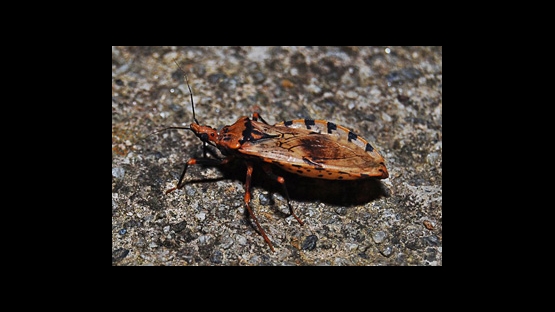The mosquito, the carrier of dengue and malaria, may be the world's most famous vector of disease but every year countless people are bitten in the night by a totally different kind of insect; a subfamily of bugs called Triatominae. There are 140 types of these Triatomines, more commonly known as kissing bugs, ranging across the globe, but the vast majority are in the Americas and it is throughout Latin America that these blood suckers' nightly search for food results in tragedy. The tragedy of the kissing bugs' kiss is that they are vectors of a parasitic protozoan called Trypanosoma cruzi, the cause of American trypanosomiasis (aka Chagas' disease), which infects humans when the bug's faeces enters the wound of the bug's bite. About 7 to 8 million people are estimated to be infected by Chagas' disease worldwide.
Once in the blood stream the protozoan parasite begins to replicate and spread throughout the body, eventually settling in the heart where it can cause dilated cardiomyopathy (DCM), a range of diseases characterised by reduced contractibility and dilatation of the heart i.e. the heart becomes weaker, enlarged and unable to pump blood efficiently. DCM is a chronic phase of Chagas' disease and is not easily cured. The prognosis of a patient with DCM becomes progressively poorer over time, with mortality rates increasing from 25% at year 1 to 50% at year 5.
The only imaging techniques that are able to give reproducible and appropriate information about hearts suffering from DCM are Gated-SPECT (Single-photon emission computed tomography) myocardial perfusion imaging (MPI) and MIBG-I123 (metaiodobenzylguanidine) scintigraphy. These two techniques rely on specialised cameras detecting radiation emitted from radioisotopes injected into a patient's bloodstream that reveals the shape and functioning of the heart. Gated-SPECT MPI produces a series of three dimensional images as the heart contracts, while MIBG-I123 scintigraphy produces a two-dimensional snapshot of the heart. The IAEA provides support and expertise to Member States about these techniques to help them treat and monitor DCM.
An ongoing technical cooperation project RLA6070 Harmonizing Nuclear Cardiology Techniques to Manage Patients Affected by Congestive Heart Failure, with an Emphasis on Chagas' Cardiomyopathy is involving the participation of 8 Member States (Bolivia, Brazil, Chile, Colombia, Cuba, Ecuador, Peru and Venezuela), with the IAEA providing technical assistance and training in the application of nuclear medicine techniques to evaluate heart failure patients. Additionally the IAEA is contributing to protocols' standardization, the establishment of a clinical algorithm using nuclear medicine techniques, as well as providing funding for Member States to acquire MIBG-I123.
Archaeological evidence suggests that Chagas' disease has been plaguing some Latin American countries for at least nine thousand years and to this day there is no vaccine for it. One of the best ways to prevent and control its spread is by controlling the kissing bug through the use of bed-nets and insecticides. Yet as long as people continue to be bitten and develop the chronic symptoms of Chagas' disease, the IAEA continues to assist Member States in employing the cardio-imaging techniques that can help save lives.


